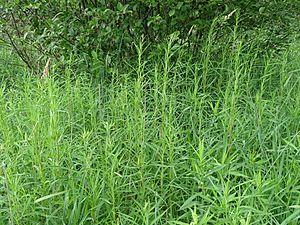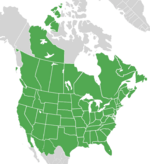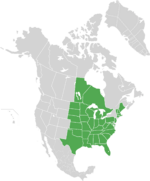Symphyotrichum lanceolatum facts for kids
Symphyotrichum lanceolatum (say: sim-fee-OH-try-kum lan-see-oh-LAY-tum) is a type of flowering plant found all over North America. It used to be called Aster lanceolatus, but scientists changed its name. Some common names for this plant are lance-leaved aster, panicled aster, and white panicled aster.
This plant is a perennial herb, which means it lives for more than two years and has soft stems, not woody ones. It can grow quite tall, sometimes reaching over 6 feet (about 2 meters)! It has a strong underground stem called a rhizome that helps it spread and form large groups of plants that are all connected.
Like all plants in the Asteraceae family (which includes sunflowers and daisies), its "flowers" are actually many tiny flowers grouped together. Each flower head has 16 to 50 white petals, called ray florets, which can sometimes look a little pink or purple. The center of the flower has about 20 to 40 tiny yellow disk florets that turn purple as they get older. The leaves are usually smooth, but they might feel a bit rough if you touch them.
Symphyotrichum lanceolatum grows in many wet, open places. You can find it near rivers and streams, in meadows, and even in ditches. It's a common plant that helps many insects. Its flowers bloom in late summer and fall, providing food for important pollinators like bumblebees, wasps, and hoverflies. People have also used this plant for medicine and grown it in gardens.
This plant spreads easily using its underground stems and by seeds carried by the wind. Because it spreads so well and can even make chemicals that stop other plants from growing, it can become an invasive species in places where it's not native, like parts of Europe.
Quick facts for kids Symphyotrichum lanceolatum |
|
|---|---|
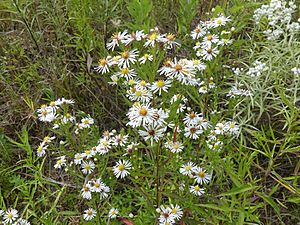 |
|
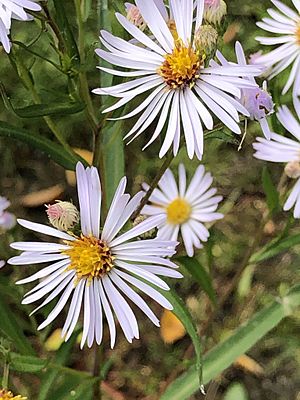 |
|
| Conservation status | |
| Scientific classification | |
| Genus: |
Symphyotrichum
|
| Species: |
lanceolatum
|
 |
|
| Native range of Symphyotrichum lanceolatum. For infraspecies ranges, see text. | |
| Synonyms | |
|
Basionym
Infraspecies
Subsp. lanceolatum
Aster abbreviatus Nees
Aster bellidiflorus Willd. Aster bellidiflorus var. rubricaulis DC. Aster cornuti J.C.Wendl. ex Nees Aster cornuti Mill. ex Nees Aster eminens Lindl. Aster lamarckianus Nees Aster lanceolatus var. monocephalus Kuntze Aster lanceolatus var. simplex (Willd.) A.G.Jones Aster lanceolatus subsp. simplex (Willd.) A.G.Jones Aster laxifolius var. laetiflorus Torr. & A.Gray Aster laxus Willd. Aster pallens Willd. Aster paniculatus var. acutidens E.S.Burgess Aster paniculatus var. bellidiflorus E.S.Burgess Aster paniculatus var. cinerascens Fernald Aster paniculatus var. lanatus Fernald Aster paniculatus var. polychrous Lunell Aster paniculatus var. simplex E.S.Burgess Aster simplex Willd. Aster simplex var. estuarinus B.Boivin Aster simplex var. ramosissimus (Torr. & A.Gray) Cronquist Aster stenophyllus Lindl. Aster tenuifolius var. bellidiflorus (Willd.) Torr. & A.Gray Aster tenuifolius var. ramosissimus Torr. & A.Gray Symphyotrichum simplex (Willd.) Á.Löve & D.Löve Var. hesperium
Aster coerulescens var. laetevirens (Greene) Cronquist
Aster coerulescens var. wootonii Wiegand Aster durus Lunell Aster fluvialis Osterh. Aster foliaceus var. hesperius (A.Gray) Jeps. Aster hesperius A.Gray Aster hesperius var. laetevirens (Greene) Cronquist Aster hesperius var. wootonii Greene Aster laetevirens Greene Aster lanceolatus subsp. hesperius (A.Gray) Semple & Chmiel. Aster lautus Lunell Aster lautus var prionoides Lunell Aster osterhoutii Rydb. Aster wootonii Greene Symphyotrichum hesperium (A.Gray) Á.Löve & D.Löve Symphyotrichum lanceolatum subsp. hesperium (A.Gray) G.L.Nesom Var. hirsuticaule
Aster lanceolatus var. hirsuticaulis Semple & Chmiel.
Var. interior
Aster interior Wiegand
Aster lanceolatus var. interior (Wiegand) Semple & Chmiel. Aster lanceolatus var. interior (Wiegand) A.G.Jones Aster lanceolatus subsp. interior (Wiegand) A.G.Jones Aster simplex var. interior (Wiegand) Cronquist Var. latifolium
Aster lanceolatus var. latifolius Semple & Chmiel.
|
|
Contents
What's in a Name?
This plant has several common names, like lance-leaved aster and panicled aster. Sometimes, people also call it a Michaelmas Daisy because it blooms around the time of Michaelmas, a fall festival.
The first part of its old scientific name, Aster, comes from an Ancient Greek word meaning "star." This makes sense because the flower heads look like little stars! The second part of its current scientific name, lanceolatum, is a Latin word that means "lance-shaped," which describes the shape of its leaves. The genus name Symphyotrichum comes from Ancient Greek words that mean "junction of hair."
Plant Description
This plant has a thick, straight stem that can grow very tall, often over 5 feet (1.5 meters) and sometimes up to 6.5 feet (2 meters). It has a strong underground stem called a rhizome that helps it spread and form large groups of plants.
The leaves near the bottom of the plant are the biggest, growing up to about 6 inches (15 cm) long. Leaves higher up on the stem are smaller. The lower leaves might have slightly jagged edges. The plant's flowers grow in large, branching clusters. Each flower head has 16 to 50 ray florets (the "petals") that can be blue, pink, or white. The disk florets (the tiny flowers in the center) start out yellow and then turn purple.
Chromosomes
Inside every living thing, there are tiny structures called chromosomes that carry genetic information. Symphyotrichum lanceolatum has a basic number of 8 chromosomes. However, different types of this plant can have different numbers of chromosomes, like 32, 40, 48, 56, or even 64! This is called polyploidy, and it means they have multiple sets of chromosomes.
Plant Families
Symphyotrichum lanceolatum belongs to a group of plants called "bushy asters and relatives." It used to be part of a larger group called Aster, but scientists found that the Aster group was too broad. So, many North American asters, including this one, were moved into the Symphyotrichum group.
This plant is divided into five main types, called varieties, which have small differences in how they look and where they grow:
- S. lanceolatum var. hesperium - Found in northern Canada, the western United States, and northwestern Mexico.
- S. lanceolatum var. hirsuticaule - Found only in the great lakes region of Canada and the United States.
- S. lanceolatum var. interior - Found in eastern Canada and the northeastern United States.
- S. lanceolatum var. latifolium - Found in eastern Canada and the eastern United States.
- S. lanceolatum var. lanceolatum - Found in eastern and central Canada and the United States. It has also been introduced to Europe.
Sometimes, this plant can even mix with other similar plants to create new hybrid plants!
Where it Grows
Symphyotrichum lanceolatum is native to most of Canada, the United States, and parts of northwestern Mexico. In these areas, it likes to grow in wet, open places like areas near rivers, in meadows, and in ditches.
This plant has also been brought to many parts of Europe, like Belgium and Latvia. There, it grows in disturbed areas and near rivers. In Europe, it can become an invasive species, meaning it spreads quickly and can push out native plants.
Ecology and Life Cycle
Symphyotrichum lanceolatum spreads widely using its underground stems (rhizomes) to form large groups of plants that are all genetically the same. It also spreads by seeds that are carried by the wind. In North America, these plant groups grow alongside grasses, goldenrods, and other asters.
However, in Europe, where it's not native, it can become an invasive species. It can take over areas near rivers and push out the plants that naturally grow there. This happens because S. lanceolatum produces special chemicals that can harm other plants around it. In Europe, it mostly spreads through its underground stems because it doesn't produce many viable seeds there.
Many different insects visit this plant, including bees, flies, moths, and wasps. These insects help the plant make seeds by moving pollen from one flower to another.
Pests and Diseases
Some tiny insects called midges can create bumps, called galls, on Symphyotrichum lanceolatum. Their young (larvae) live inside these galls. For example, one midge species can make the flowers or buds stop growing.
There's also a cool partnership between a leaf-blister gall midge and a fungus. The fungus gets extra food from the midge larva, and in return, it gives the midge some protection.
Other insects that feed on this plant include leaf-mining insects, which tunnel inside the leaves. Young gorgone checkerspot caterpillars also eat S. lanceolatum.
Conservation Status
Overall, Symphyotrichum lanceolatum is considered a "Secure" species around the world. This means it's not currently at risk of disappearing. However, in a few specific places, like Iowa, North Carolina, and Newfoundland, it is considered "Vulnerable" or "Imperiled," meaning it needs more protection there.
Some of its specific varieties also have different statuses. For example, S. lanceolatum var. interior is possibly gone from New York state and Quebec, and it's critically imperiled in New Jersey.
Uses
In its native North America, indigenous peoples used Symphyotrichum lanceolatum for various medicinal purposes. For example, the Zuni people in the American Southwest used it to treat wounds and nosebleeds. The Iroquois people in what is now Eastern Canada used it to help with fevers.
This plant is also grown in gardens as an ornamental plant because of its pretty flowers. It can also be used in the cut flower industry, meaning its flowers are cut and sold for bouquets.




